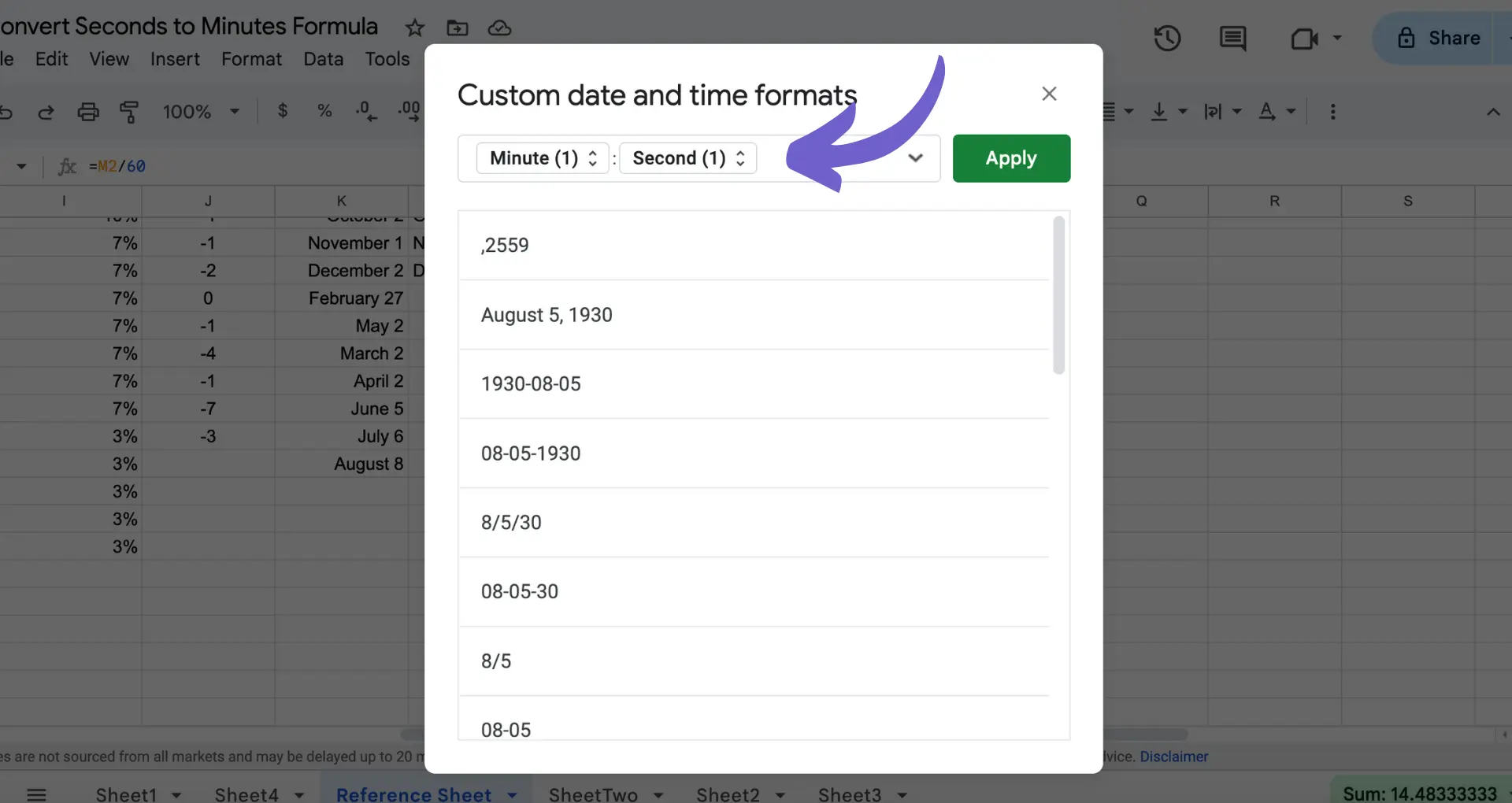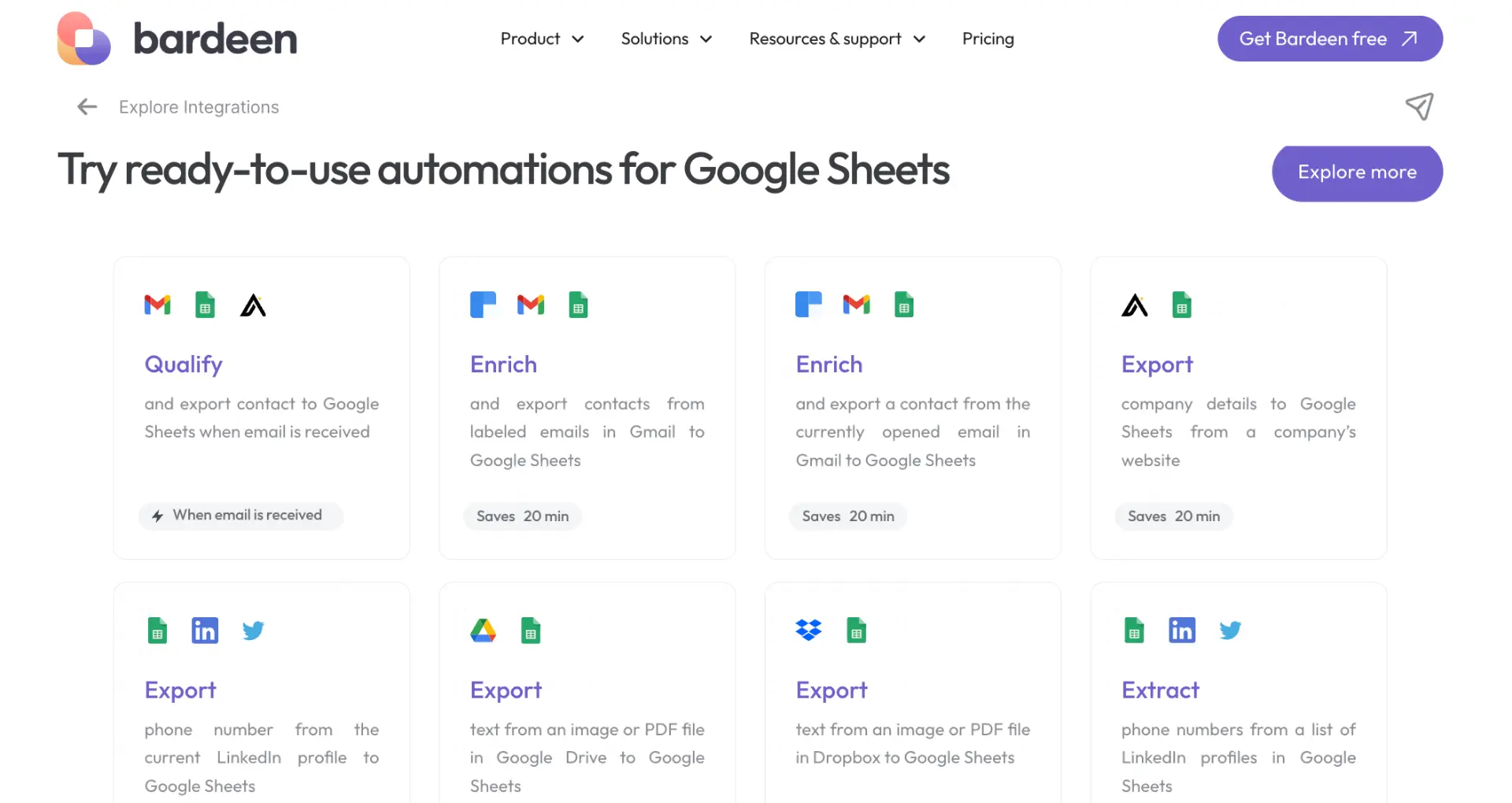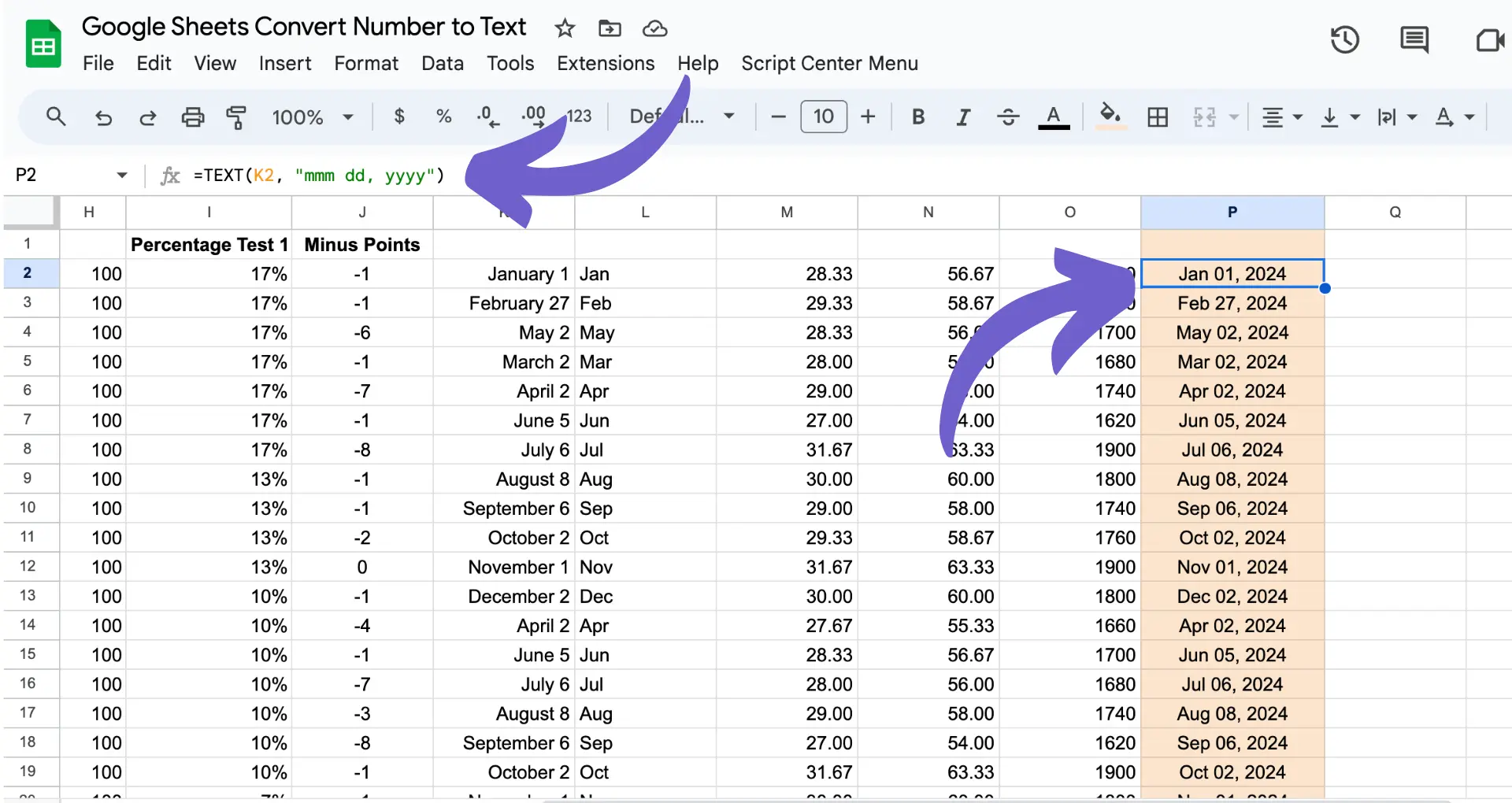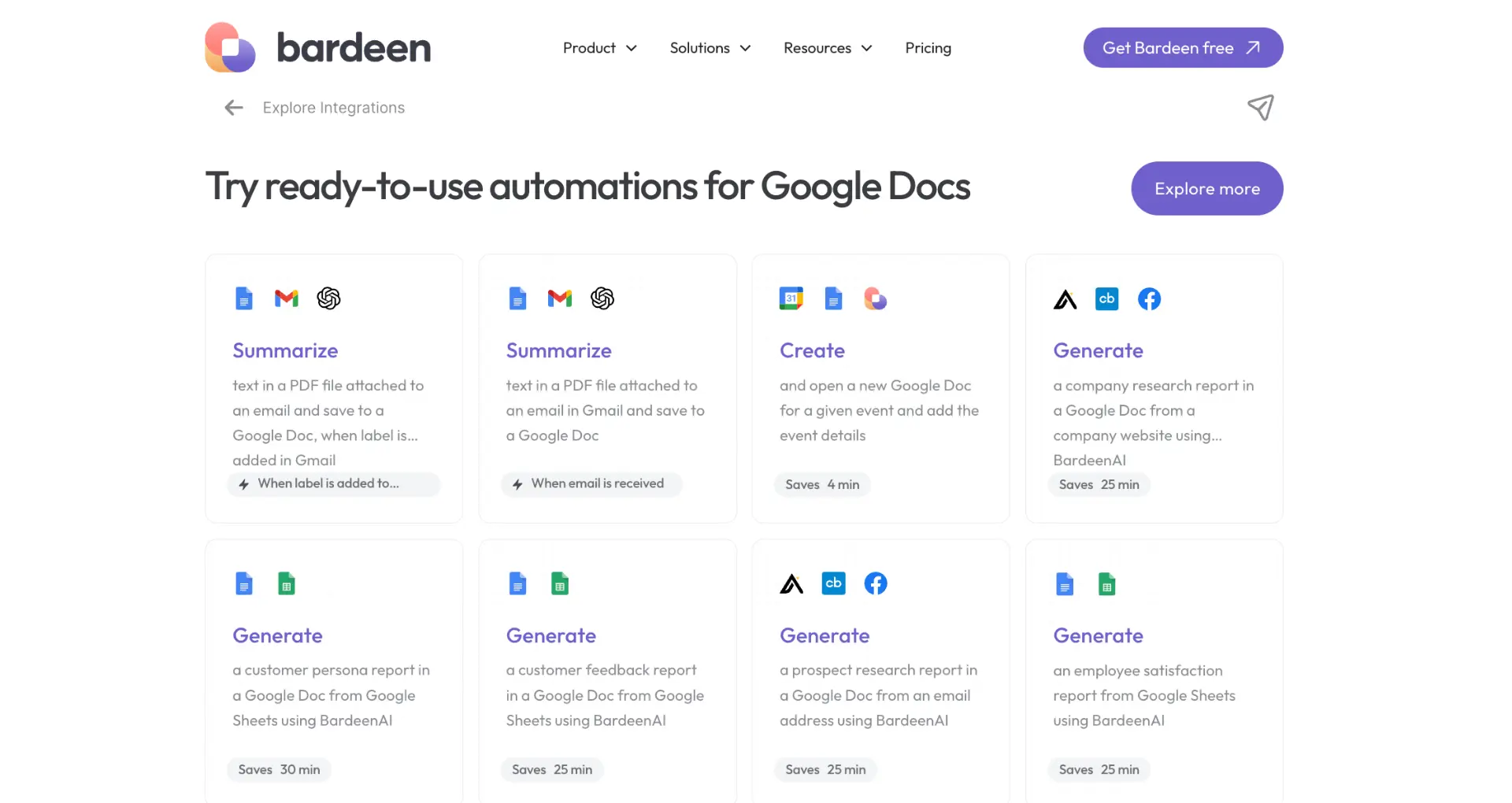Click Format, Number, and select the desired date format.
By the way, we're Bardeen, we build a free AI Agent for doing repetitive tasks.
If you work with spreadsheets, you might love Bardeen's automation features. It helps automate date formatting and other repetitive tasks in Google Sheets.
Converting date formats in Google Sheets can be a tricky task, especially when dealing with different locales and formatting requirements. In this step-by-step guide, we'll walk you through the process of converting date formats in Google Sheets, from understanding the basics to utilizing advanced techniques and troubleshooting common issues. Whether you're working with simple date conversions or need to automate the process for large datasets, this guide will provide you with the knowledge and tools to master date formatting in Google Sheets.
Understanding Google Sheets Date Format Basics
Google Sheets stores dates as serial numbers, with January 1, 1900, as the starting point (serial number 1). This internal representation affects how dates are formatted and displayed in your spreadsheet. To ensure that your dates appear correctly, it's essential to understand the relationship between serial numbers and date formatting.
Spreadsheet locale settings also play a crucial role in date displays. Different locales have varying conventions for representing dates, with the most notable difference being between US (MM/DD/YYYY) and European (DD/MM/YYYY) formats. When working with dates in Google Sheets, be mindful of your spreadsheet's locale settings to avoid confusion and ensure consistency. For more advanced features, you can bring AI into your spreadsheet to automate tasks.

Here are a few key points to remember about date formats in Google Sheets:
- Dates are stored as serial numbers, with each integer representing a single day.
- Locale settings determine the default date format and the character used as the decimal separator.
- US locale displays dates as MM/DD/YYYY, while European locales use DD/MM/YYYY.
- Changing the locale settings will not automatically update existing date formats in your spreadsheet.
How to Manually Change Date Formats in Google Sheets
To manually change the date format in Google Sheets, follow these step-by-step instructions:
- Open your Google Sheets spreadsheet and select the cells containing the dates you want to format.
- Click on the "Format" menu in the toolbar and hover over "Number."
- Choose the desired date format from the list of options, such as "3/14/2012" for MM/DD/YYYY or "14/3/2012" for DD/MM/YYYY.

If you don't see the format you need, click on "More formats" and then "More date and time formats" to access additional options or create a custom date format.
When working with dates in Google Sheets, it's crucial to ensure that your spreadsheet's locale settings match the date format you're using. To check or change your locale settings:
- Click on "File" in the menu bar and select "Spreadsheet settings."
- In the "General" tab, locate the "Locale" option and choose the appropriate setting from the dropdown menu.
- Click "Save settings" to apply the changes.
By selecting the correct locale and date format, you can ensure that your dates are accurately represented and avoid confusion when sharing or collaborating on your Google Sheets spreadsheet. For more advanced tips, check out how to connect Google Sheets with other apps for better productivity.
Save time with Google Sheets automation using Bardeen. Automate repetitive tasks to focus on what's important.

Utilizing Functions to Convert Dates in Google Sheets
Google Sheets offers several functions to manipulate and convert date formats, making it easy to work with dates in your spreadsheets. Here are some of the most commonly used functions:
- TEXT(): This function converts a date to a text string in a specified format. For example,
TEXT(A1, "mm/dd/yyyy")would convert the date in cell A1 to the format "MM/DD/YYYY". - DATE(): This function creates a date value from given year, month, and day values. For example,
DATE(2023, 4, 15)would return the date value for April 15, 2023. - TO_DATE(): This function converts a number or text string to a date value. For example,
TO_DATE("4/15/2023")would return the date value for April 15, 2023.

Here's a practical example of using the TEXT() function to convert a date:
- Suppose you have a date in cell A1 in the format "4/15/2023".
- To convert this date to the format "April 15, 2023", you would use the following formula:
=TEXT(A1, "mmmm d, yyyy") - The result would be the text string "April 15, 2023".
By combining these functions with other Google Sheets features, you can easily manipulate and format dates to suit your needs. For more advanced tasks, consider how to scrape data from websites and integrate it into your spreadsheets.
Automating Date Conversions Using Array Formulas
Google Sheets offers a powerful feature called ARRAYFORMULA that allows you to apply date conversions across multiple rows or columns simultaneously. By combining ARRAYFORMULA with the TEXT() function, you can format dates in bulk, saving time and effort.
Here's an example of how to use ARRAYFORMULA and TEXT() together:
- Suppose you have a range of dates in cells A1:A10 in the format "MM/DD/YYYY".
- In cell B1, enter the following formula:
=ARRAYFORMULA(TEXT(A1:A10,"YYYY-MM-DD")) - This formula will automatically convert and format all the dates in the range A1:A10 to the "YYYY-MM-DD" format and display the results in the corresponding cells of column B.
The beauty of ARRAYFORMULA is that it eliminates the need to drag the formula down the column. It automatically applies the conversion to all the cells in the specified range.
You can customize the date format within the TEXT() function to suit your needs. For example, to display the dates as "DD MMM YYYY", you would use: =ARRAYFORMULA(TEXT(A1:A10,"DD MMM YYYY"))
By leveraging the power of ARRAYFORMULA and TEXT(), you can efficiently convert and format dates across your spreadsheet, bring AI into your spreadsheet, and ensure consistency in your data.
Use Bardeen to connect Google Docs and automate tasks across Google apps.

Advanced Custom Date Formatting Techniques
Google Sheets allows you to create highly customized date formats that go beyond the standard options. By using custom date and time codes, you can include textual elements like day names or month names in your date displays.
To create a custom date format:
- Select the cells containing the dates you want to format.
- Go to Format > Number > More formats > More date and time formats.
- In the "Custom date and time format" field, enter your desired format using the following codes:
dddfor abbreviated day name (e.g., Mon, Tue)ddddfor full day name (e.g., Monday, Tuesday)mmmfor abbreviated month name (e.g., Jan, Feb)mmmmfor full month name (e.g., January, February)

For example, to display dates as "Monday, January 1, 2023", you would enter the following custom format: dddd, mmmm d, yyyy
You can also combine these codes with other date and time elements, such as:
dfor day of the month (1-31)mfor month (1-12)yyoryyyyfor two-digit or four-digit yearhfor hour (1-12)mmfor minute (00-59)ssfor second (00-59)AM/PMfor 12-hour time format
By mixing and matching these codes, you can create highly specific date displays tailored to your needs. Experiment with different combinations to find the perfect format for your spreadsheet. For even more advanced capabilities, check out GPT in Google Sheets to automate and enhance your spreadsheet workflows.
Troubleshooting Common Date Format Issues in Google Sheets
When working with dates in Google Sheets, users may encounter various issues related to formatting or interpretation. Here are some common problems and their solutions:
- Incorrect locale settings: If your dates appear in an unexpected format, check your spreadsheet's locale settings. Go to File > Spreadsheet settings > General, and ensure the "Locale" option is set correctly for your region.
- Misinterpretation of date formats: Google Sheets may misinterpret dates entered in a format that doesn't match the spreadsheet's locale. To avoid this, use a consistent date format or enter dates using the DATE function, e.g.,
=DATE(2023,3,15). - Text-based dates: If your dates are stored as text (e.g., "3/15/2023"), they won't be recognized as actual dates. To convert text-based dates to proper date values, use the DATEVALUE function, e.g.,
=DATEVALUE("3/15/2023"). - Formatting not applying: If you've changed the date format but it's not taking effect, try copying the dates to a new column using "Paste special" > "Values only." Then, reapply the desired date format to the new column.
To ensure dates are entered correctly and consistently, consider using data validation in Google Sheets:
- Select the cells where you want to enforce date formatting.
- Go to Data > Data validation.
- Under "Criteria," choose "Date" and set the desired format.
- Click "Save" to apply the validation rule.
By following these tips and using data validation, you can minimize date formatting issues and maintain a consistent date representation throughout your Google Sheets spreadsheet.
Want to effortlessly handle date formatting? Automate your Google Sheets tasks with Bardeen to save time and ensure consistency.
Automate Google Sheets with Bardeen: A Game Changer
Converting date formats in Google Sheets can be done manually as detailed above, or it can be automated for efficiency and accuracy. Automating this process with Bardeen not only saves time but ensures data consistency across your documents. Whether for reporting, analytics, or simply organizing your data, automating date format conversion can streamline your workflows. Here are some examples of how Bardeen can automate tasks related to Google Sheets:
- Save data from the Google News page to Google Sheets: This playbook automates the process of extracting and saving the latest news information directly into your Google Sheets. Ideal for keeping up with current events or industry trends relevant to your data analysis needs.
- Copy a table from Airtable to Google Sheets every day: Automate daily data transfer from Airtable to Google Sheets to ensure your data is always up-to-date, saving you the hassle of manual updates.
- Copy a newly created Asana task to Google Sheets: Keep your project management in sync by automatically copying new Asana tasks into a Google Sheets spreadsheet. Perfect for tracking tasks and progress across platforms.
These automation examples demonstrate how Bardeen can enhance your Google Sheets experience, making data management more efficient and effective. Download the Bardeen app at Bardeen.ai/download to start automating your workflows.






.svg)
.svg)
.svg)
